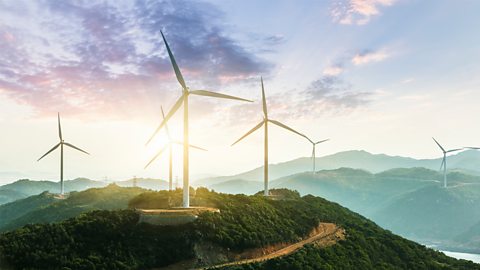The Greenhouse Effect
When fossil fuels burn, they produce greenhouse gasThe gases responsible for global warming - carbon dioxide, methane, nitrous oxide and CFCs (chlorofluorocarbons). that are having a global impact on temperature and weather systems.
Fossil fuels and greenhouse gases
When fossil fuelNatural, finite fuel formed from the remains of living organisms, eg oil, coal and natural gas. are burned by industry, in power stations and by vehicles and planes, gases (as unwanted by-products known as carbon emissions) enter the atmosphereThe layers of gases that surround the Earth. The important gases in the atmosphere are nitrogen, oxygen and carbon dioxide..
Carbon dioxide (CO2) is given off when fossil fuels, such as oil and coal, are burned.
Although these gases have always been present in the world's atmosphere, their concentration is gradually increasing as more and more fossil fuels are burned.
Greenhouse gases
Scientists believe that the build-up of so-called greenhouse gases in the atmosphere acts like a blanket or greenhouse around the planet; heat is trapped inside the Earth's atmosphere.
This is the greenhouse effect, and the resulting increase in global temperatures is called global warmingThe rise in the average temperature of the Earth's surface..
Plants and trees need CO2 and use it up. However, if there is too much CO2 in the atmosphere - due to factories and power stations, combined with a reduction in the number of trees, through deforestation - CO2 builds up in the atmosphere.
The build-up of CO2 is believed to contribute to global warming through the greenhouse effectThe trapping of the sunâs heat in the earthâs atmosphere by gases such as methane, carbon dioxide and water vapour. An increased greenhouse effect can lead to climate change.. This is why CO2 is one of the greenhouse gases.
The biggest producers of CO2 in the world are China, the United States (USA), India, Russia, Japan, Iran, Germany, Saudi Arabia, Indonesia, South Korea and Canada.
The largest producers by far are China and the USA.
The diagram below shows the countries that contribute the biggest percentage of the world's carbon emissions.
How the Greenhouse Effect works
It's thought that the build-up of greenhouse gasThe gases responsible for global warming - carbon dioxide, methane, nitrous oxide and CFCs (chlorofluorocarbons). impacts on global temperature in two ways:
The gases allow more of the sun's rays to enter the atmosphere. Some solar radiationEnergy from the sun - consisting of visible light, heat or infra-red radiation, ultra-violet and other forms of radiation. is still reflected back into space by the outer parts of the atmosphere, but it's believed the amount reflected back is gradually reducing.
At the same time, the greenhouse gases absorb more of the solar radiation that is reflected back from the Earth's surface - trapping heat and keeping it in the atmosphere. The ability of the atmosphere to capture the Sun's warmth is essential for life on earth. But if significantly more warmth is being captured, this is bad news for the planet.
The greenhouse effect therefore helps to keep the earth a little warmer than normal and this can lead the climate to change as global warmingThe rise in the average temperature of the Earth's surface. causes the atmosphere to warm up.
Many scientists believe that the carbon that is part of fossil fuels (coal, oil and natural gas), is one of main causes for the increase in carbon dioxide.
This then makes a much bigger contribution to the increase in greenhouse effect than any of the other gases.
Carbon footprint
The impact of carbon dioxide on the environment
A carbon footprintThis is the total set of greenhouse gas emissions that are caused by an organisation, event, product or person. However, it is more usually taken as a measure of carbon dioxide and methane emissions within a population. is a measure of the impact our activities have on the environment.
It calculates the greenhouse gasThe gases responsible for global warming - carbon dioxide, methane, nitrous oxide and CFCs (chlorofluorocarbons). we are expected to produce in all our activities and measures them in units of carbon dioxide (CO2).
The world average is about 4,690 kg of carbon dioxide per person per year. In the UK it is approximately 10,000 kg per person per year.
This pie chart shows what contributes to the carbon footprint of a typical person living in an MEDC.
As a country develops, its carbon footprint tends to increase.
This pattern is shown in the graph below, with MEDCMore Economically Developed Country â usually a rich country found in Western Europe or North America. emitting the most carbon dioxide.
| Country | 1990 | 2006 |
|---|---|---|
| Qatar | 25.2 | 56.2 |
| United Arab Emirates | 29.4 | 32.8 |
| United States | 19.0 | 19.0 |
| Australia | 17.4 | 18.1 |
| Singapore | 15.6 | 12.8 |
| Japan | 9.5 | 10.1 |
| Germany | 12.1 | 9.7 |
| United Kingdom | 10.0 | 9.4 |
| South Africa | 9.1 | 8.6 |
| Italy | 7.5 | 8.1 |
| Thailand | 1.8 | 4.3 |
| Egypt | 1.4 | 2.2 |
| Brazil | 1.4 | 1.9 |
| Kenya | 0.2 | 0.3 |
| Bangladesh | 0.1 | 0.3 |
| Sierra Leone | 0.1 | 0.2 |
| Ethiopia | 0.1 | 0.1 |
Effects of climate change
Scientists, politicians and industrialists continue to debate the causes of global warmingThe rise in the average temperature of the Earth's surface., with some arguing that it is a natural process that's been going on for centuries.
However, the Intergovernmental Panel on Climate Change (IPCC) has stated that the evidence suggests that human activity does affect global warming, in particular through the release of greenhouses gases and the use of aerosolsAerosol sprays contain pressurised liquids which are released as a fine spray by the use of gas. Before 1989 they used chlorofluorocarbons (CFCs) which were found to damage the Earth's ozone layer..
There is also debate over how quickly the earth is warming up.
Some scientists estimate that atmospheric temperatures could rise by 1.4°C - 5.8°C in the next 100 years. Others believe that they will rise more slowly.
Whatever the causes and timescale, the implications of global warming are very serious.
The map above shows which countries are responsible for the most emissions. LEDCLess Economically Developed Country â usually a poorer country found in South America, Africa or Asia. want to develop and to catch up with MEDCMore Economically Developed Country â usually a rich country found in Western Europe or North America. and this normally means using more energy and burning more fuel. So global warming could threaten developmentA measure of wealth and quality of life for humans within a country or area. Each country will make economic and social progress or change at a different rate..
Global warming could melt the world's ice caps and glaciers, leading to an increase in sea levels. Some scientists estimate that over the next hundred years sea levels could rise by between 10 cm and 90 cm - making many coastal areas around the world uninhabitable.
Global warming could also affect the weather patterns, leading to more droughts, flooding and extreme weather, such ashurricaneThe strongest of tropical storm with circling winds of more than 117 km/h. Hurricanes, typhoons and tropical cyclones are the same thing, but in different parts of the world..
Some climatologists argue that the UK climate is changing as a result of global warming, with the possibility of more frequent floods, water shortages, and extreme weather conditions.
Effects on the environment
Increasing temperatures: The global temperature has risen by over 0.75 degrees in the last century and there are signs that this has been on the increase.
Increasing rainfall: Patterns of rainfall have been changing. Wet places have been getting wetter and dry places have been getting drier. Scientists have noticed that seasons have been changing as well. British summers have been wetter whilst the winters have been drier than usual
Seasonal variation: Nature experts have noted that animal behaviour has changed with butterflies appearing earlier and many birds have different migration patterns than they once did.
Glacier/Ice cap melt: The warmer global temperatures meant that polar icecaps and glaciers in high ground started to melt. Some suggest that ice has retreated by around 25% and there were reports in summer 2017 that large sections of the Antarctica ice shelf were breaking off or âcalvingâ from the Larsen C ice shelf.
Sea level changes: From 1900 the sea levels around the UK have risen by 10cm and around the world the sea level has risen by around 17cm. As the ice melts around the world the amount of water released will continue to rise. Many scientists believe that sea levels could be 1m higher in 2100 compared to now.
Changing living conditions: Many species of plants and animals will find they have to adapt to survive the changing climate conditions. In the Arctic, polar bears are at risk as they have to swim much further between ice flows which uses up a lot more energy.
Effects on people
Food: As the seasons change, many farmers will need to consider the crops that they plant. They might need to change to suit the changing conditions.
Health: Many of the worldâs poorest people are at serious risk as climates change. There will be issues with food supply and increases in malnutrition. Extreme weather events such as drought, floods and storms will injure and kill more people.
Water: Although there might be more rain it will be less predictable for farming and crops.
Death: Death rates will increase. The UN estimate that over 300,000 people die each year already due to climate changeThe greenhouse effect is one of the most common causes of global warming. This means that the atmospheric temperatures are increasing and these have caused the global climate to change.. Diseases such as malaria and cholera will also be on the increase.
Effects on the economy
Farming: Many of the traditional patterns of farming will change. Grain harvests might improve due to higher temperatures, however in other areas drought could bring disaster.
Flooding: Increases in amounts of rainfall will lead to increased river and coastal flooding. This can bring huge amounts of damage to property and houses which can cost a lot to fix.
Travel and Tourism: Different countries have started to increase the amount of tax payable on air travel. As air travel is one of the heaviest polluters of the atmosphere, different measures are being taken to invest in cleaner aircraft and technologies. Travel will become increasingly expensive.
Green economy: Pressure from global and environmental organisations has meant that many countries have had to come up with strategies designed to help tackle climate issues. A transition from carbon-burning vehicles and home heating systems means that people have to invest in new âgreenâ technologies e.g wind power.
How the greenhouse effect can contribute to climate change.
More on Managing our environment
Find out more by working through a topic
- count2 of 3

- count3 of 3
